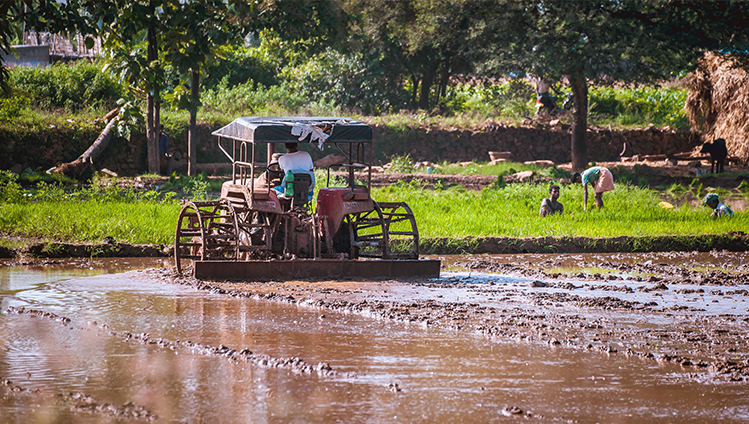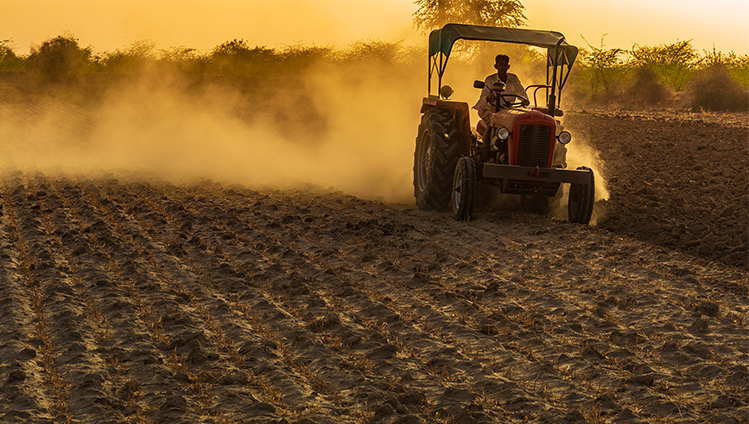With 3.3 million square kilometers, India is the seventh largest country in the world. The landscape is predominated by rice fields interspersed with areas where millet, wheat, legumes and fruit are grown. The tropical to subtropical climate shapes the lives of the approximately 1.33 billion people on this patch of the earth. High temperatures prevail the whole year – the monsoon rain arrives from July to October. This does not make field work easy. And yet, around half of India's population income is primarily from agriculture. This is due to the fact that rice is one of the key staple foodstuffs in the Asia region, making its cultivation vitally important.
Heat and humidity complicate cultivation
 But the harsh weather conditions in India are a real endurance test for man and machine. The sweltering temperatures and swampy soil cause the field workers to stand ankle-deep in the water. Agricultural machinery is the only thing that makes the hard work in the fields easier. But, "The muddy farmland and the oppressive heat also put a strain on the machines and do not always allow for easy maintenance," says Thorsten Schwefe, who works in the drive belt sales team. What the local population needs are agricultural machines able to withstand the tough conditions of Indian agriculture. From the engine to all other components: Everything must function reliably. This is
But the harsh weather conditions in India are a real endurance test for man and machine. The sweltering temperatures and swampy soil cause the field workers to stand ankle-deep in the water. Agricultural machinery is the only thing that makes the hard work in the fields easier. But, "The muddy farmland and the oppressive heat also put a strain on the machines and do not always allow for easy maintenance," says Thorsten Schwefe, who works in the drive belt sales team. What the local population needs are agricultural machines able to withstand the tough conditions of Indian agriculture. From the engine to all other components: Everything must function reliably. This is
where high-performance drive systems will be most called for.
 We can provide Mahindra – the Indian agricultural machinery manufacturer – with precisely the level of drive performance required – directly on site from local production facilities. 500,000 high-performance belts specially designed for demanding drives are produced annually by our Sonepat employees for the company. They drive the water pump, alternator and dynamos in tractors, for example. In combine harvesters, Mahindra uses V-belts primarily for the main drive. Our products are optimally adapted to the hard use in the fields and master every challenge there.
We can provide Mahindra – the Indian agricultural machinery manufacturer – with precisely the level of drive performance required – directly on site from local production facilities. 500,000 high-performance belts specially designed for demanding drives are produced annually by our Sonepat employees for the company. They drive the water pump, alternator and dynamos in tractors, for example. In combine harvesters, Mahindra uses V-belts primarily for the main drive. Our products are optimally adapted to the hard use in the fields and master every challenge there.
Right on the spot and therefore within easy reach
Mahindra does not only appreciate the high quality of our belts: The population figures in Asian countries are constantly increasing – the demand for food is therefore very high. In order to meet the demand, fast-growing rice varieties are mainly used in India. As a rule, harvesting takes place three times a year. This imposes additional stress on agricultural machinery. This leads to faster wear and tear and high maintenance costs. It is therefore convenient if the contact person is located directly on site and can react immediately to any questions or problems.
 |
Thorsten Schwefe is responsible for the technical sales of our drive belts for agricultural machinery:
"Our recipe for success for the Indian agricultural industry: We supply the high quality that this demanding market requires and we can be quickly contacted in India." |
According to Schwefe, it is precisely this local factor and proximity to the customer that will also be advantageous in the future. Especially since the Indian market is currently developing rapidly. "It's just at the beginning in agriculture when it comes to mechanization and automation, but at the same time it offers a lot of potential for development," says Schwefe. There is room for us to further expand our business in India. A great opportunity for Mahindra to produce even stronger and more reliable agricultural machinery. For the many people working in the agricultural sector in India, there is enormous growth potential for even more efficient machines to make their work easier. And there is plenty of opportunity to reliably supply the Indian population with foodstuffs. It’s a win-win situation for everyone.